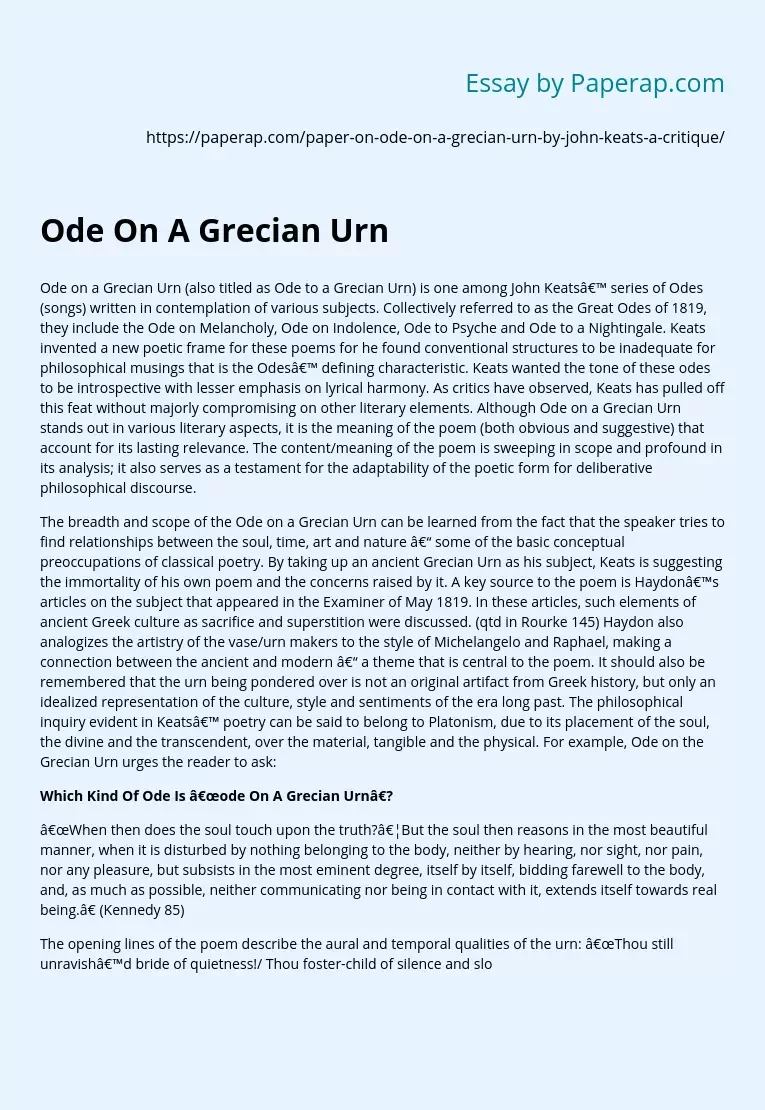Ode on a Grecian Urn (also titled as Ode to a Grecian Urn) is one among John Keats’ series of Odes (songs) written in contemplation of various subjects. Collectively referred to as the Great Odes of 1819, they include the Ode on Melancholy, Ode on Indolence, Ode to Psyche and Ode to a Nightingale. Keats invented a new poetic frame for these poems for he found conventional structures to be inadequate for philosophical musings that is the Odes’ defining characteristic. Keats wanted the tone of these odes to be introspective with lesser emphasis on lyrical harmony.
As critics have observed, Keats has pulled off this feat without majorly compromising on other literary elements. Although Ode on a Grecian Urn stands out in various literary aspects, it is the meaning of the poem (both obvious and suggestive) that account for its lasting relevance. The content/meaning of the poem is sweeping in scope and profound in its analysis; it also serves as a testament for the adaptability of the poetic form for deliberative philosophical discourse.
The breadth and scope of the Ode on a Grecian Urn can be learned from the fact that the speaker tries to find relationships between the soul, time, art and nature – some of the basic conceptual preoccupations of classical poetry. By taking up an ancient Grecian Urn as his subject, Keats is suggesting the immortality of his own poem and the concerns raised by it. A key source to the poem is Haydon’s articles on the subject that appeared in the Examiner of May 1819.
In these articles, such elements of ancient Greek culture as sacrifice and superstition were discussed. (qtd in Rourke 145) Haydon also analogizes the artistry of the vase/urn makers to the style of Michelangelo and Raphael, making a connection between the ancient and modern – a theme that is central to the poem. It should also be remembered that the urn being pondered over is not an original artifact from Greek history, but only an idealized representation of the culture, style and sentiments of the era long past. The philosophical inquiry evident in Keats’ poetry can be said to belong to Platonism, due to its placement of the soul, the divine and the transcendent, over the material, tangible and the physical. For example, Ode on the Grecian Urn urges the reader to ask:
Which Kind Of Ode Is “ode On A Grecian Urn”?
“When then does the soul touch upon the truth?…But the soul then reasons in the most beautiful manner, when it is disturbed by nothing belonging to the body, neither by hearing, nor sight, nor pain, nor any pleasure, but subsists in the most eminent degree, itself by itself, bidding farewell to the body, and, as much as possible, neither communicating nor being in contact with it, extends itself towards real being.” (Kennedy 85)
The opening lines of the poem describe the aural and temporal qualities of the urn: “Thou still unravish’d bride of quietness!/ Thou foster-child of silence and slow time”. (lines 1-2) The creator of the urn is not a merchant in words as a poet is; hence the ‘foster-child of silence’. Since stone artifacts deteriorate very little over long periods of time, the references to ‘slow time’ and ‘unravished’. Addressing the urn as the ‘Sylvan historian’ in the next line further reinforces the eternal character of the object in admiration. The series of questions toward the end of the first stanza, underscore the broader philosophical reach of the poem through the details of the artifact. Although these questions are vague and sketchy, they do capture the direction and outline of Keats’ philosophical inquiry: “What men or gods are these? What maidens loth?/ What mad pursuit? What struggle to escape?/ What pipes and timbrels? What wild ecstasy?” (lines 8-10) The words ‘pursuit’, ‘escape’ and ‘ecstacy’, do give away the sexual component of these questions.
Looked at cursorily, an urn is an unimpressive and poetically unpromising addressee. This has lent license to some critics to see the object as a funeral urn, which provides them the opportunity
“to enrich the poem with ponderous thoughts on death and transitoriness, or with a plethora of symbolic lore. Conversely, other critics have valiantly embraced the precariousness of the inappropriate object with an emphasis on the abject state of the disused utensil, the piece of debris, which through this abasement is elevated to the state of art. From this point of view Keats’ Ode is regarded as ancestral to surrealist translations of discarded utensils into art objects.” (Hofmann 251)
The genius of Keats is at display where he juxtaposes the static scene imprinted in the urn and its possible dynamic animation in real life. What Keats is implying is the magical quality of time itself, as it empowers and liberates the players in the scene to fulfill their desires. Yet, there is potential for decay and disappointment associated with the nature of time, which the immortality of static encapsulation evades. This comparison is best captured in these lines: “Bold Lover, never, never canst thou kiss,/ Though winning near the goal – yet, do not grieve;/ She cannot fade, though thou hast not thy bliss,/ For ever wilt thou love, and she be fair!” (lines 17-20) Hence, the poem is rich in its meaning and deep in its philosophical inquisition and also substantiates the poetic form’s suitability to thoughtful deliberation.
Works Cited:
Hofmann, Klaus. “Keats’s Ode to a Grecian Urn.” Studies in Romanticism 45.2 (2006): 251+. Kennedy, Thomas C. “Platonism in Keats’s ‘Ode on a Grecian Urn.’.” Philological Quarterly 75.1 (1996): 85+. Rourke, James O’. Keats’s Odes and Contemporary Criticism. Gainesville, FL: University Press of Florida, 1998.
Ode On A Grecian Urn. (2019, Dec 05). Retrieved from https://paperap.com/paper-on-ode-on-a-grecian-urn-by-john-keats-a-critique/

